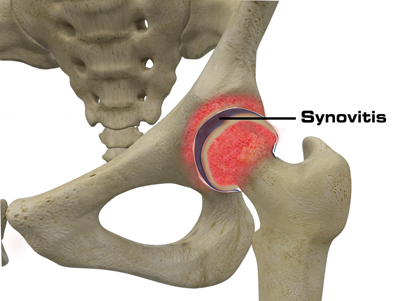Transient hip synovitis is inflammation that affects the synovial membrane, a tissue that lines the hip joint, leading to symptoms such as pain on one or both sides of the hip and, in some cases, pain in the groin, thigh, or hip joint. knee.
This condition is most common in children aged 3 to 10 years, but can affect adults as well, and is usually caused after an infection by a virus or bacteria that can enter the bloodstream and travel to the hip joint. Thus, it is common for symptoms to manifest after an episode of flu, cold, sinusitis or ear infection, for example.
Transient hip synovitis usually improves on its own, without the need for specific treatment, however, it is important to consult a pediatrician or an orthopedist to evaluate the symptoms and, in some cases, the doctor may recommend treatment with analgesics or anti-inflammatory drugs. , for example.
main symptoms
Transient synovitis occurs in the hip joint, and the main symptoms are:
- Pain inside the hip joint;
- Pain in the front of the hip;
- Swelling in the affected area of the hip;
- Pain in the groin, thigh or knee;
- Hip pain that gets worse when moving
- Difficulty walking;
- to walk with a limp;
- Difficulty putting the foot on the floor.
Transient hip synovitis can affect one or both sides of the hip, and it is important to consult an orthopedist or pediatrician to identify and initiate the most appropriate treatment.
How to confirm the diagnosis
The diagnosis of transient hip synovitis is made by the pediatrician or by the orthopedist through the analysis of symptoms and blood tests such as blood count, C-reactive protein or sedimentation rate (ESR), to identify inflammation or infections in the body. Understand better what the VHS exam is.
In addition, to rule out other diseases that may have the same symptoms, such as Legg Perthes Calvés, tumors or rheumatic diseases, the doctor may order tests such as X-ray, ultrasound or MRI of the hip.
Another test that the doctor may order is an analysis of synovial fluid to identify the cause of inflammation and pain in the hip joint. This analysis is done by taking a small sample of fluid from the joint, which will be analyzed in the laboratory.
Possible causes
The exact cause of transient synovitis is still unknown, however, some studies show that it can be caused by situations such as:
- Viral infection;
- Bacterial infection;
- Trauma to the hip joint, such as blows, accidents, falls, or fractures;
- Reactions after taking vaccines;
- Allergic diseases;
- Severe allergic reaction caused by medication.
These conditions can lead to inflammation of the synovial membrane of the hip joint, which becomes thicker and has more blood vessels, as well as increased production of synovial fluid.
How is the treatment done?
Transient hip synovitis usually improves on its own without the need for specific treatment. However, your doctor may recommend rest, in a comfortable position, to aid recovery and relieve pain and discomfort that comes with moving or walking.
In addition, your doctor may recommend applying warm compresses or hip massage, or using anti-inflammatory or pain relievers, such as acetaminophen or ibuprofen, to relieve pain and inflammation.
